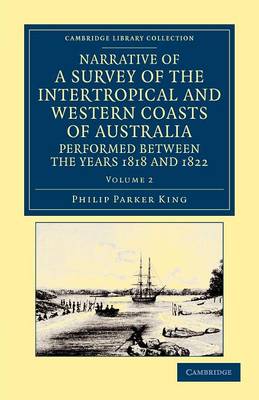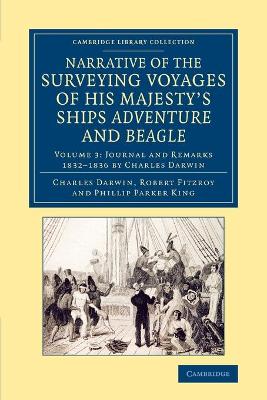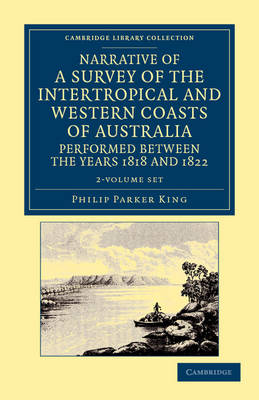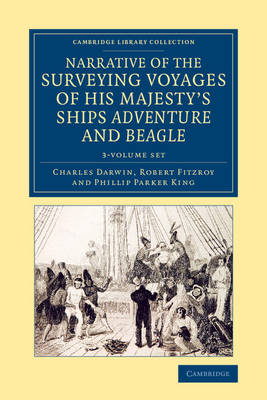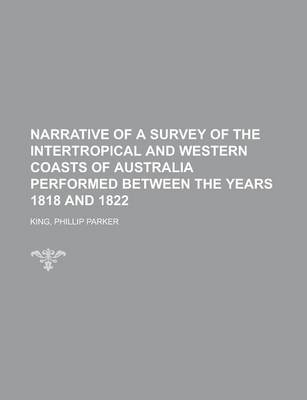Cambridge Library Collection - Maritime Exploration
2 primary works • 6 total works
Volume 1
This two-volume work by Captain Phillip Parker King (1791–1856) was published in 1827, and describes the Royal Navy's 1817–22 surveying expedition to chart the coastal regions of Australia. King carried out the surveys in two successive ships, the Mermaid, which was declared unseaworthy in 1820, and the newly commissioned Bathurst. He worked on the charts, which were published by the Hydrographic Office, for two years after his return to England. He was made a Fellow of the Royal Society, and later undertook a similar surveying voyage, in which he was accompanied by Captain Fitzroy on the Beagle, around the coast of South America. The book is derived from the author's journal, and describes not only the voyages but also the towns and settlements of the region. Volume 2 continues the survey along the north and west coasts of Australia, and contains an appendix describing winds, currents, ports and islands.
Volume 2
Narrative of the Surveying Voyages of His Majesty's Ships Adventure and Beagle
by Charles Darwin, Robert Fitzroy, and Phillip Parker King
Published 2 July 2015
In the years leading up to Charles Darwin's 1832-6 voyage on the Beagle, the ship and its captain Robert Fitzroy (1805-65) had participated in an expedition to the desolate southern coast of South America. This three-volume work, published in 1839, describes both voyages. Volumes 1 and 2, compiled by Fitzroy, contain accounts by professional mariners. Volume 3 is the first published version of the young Darwin's now famous journal. It later appeared as a free-standing publication (1840) and in a more popular second edition (1845), both reissued in this series. Darwin's preface refers to the detailed scientific publications resulting from his research: the geological studies of volcanic islands and coral reefs (also available in the Cambridge Library Collection), and the co-authored, multi-volume zoology. Darwin expresses thanks to Fitzroy for his 'most cordial friendship', to the ship's officers for their 'undeviating kindness', and particularly to his Cambridge mentor John Stevens Henslow.
This two-volume work by Captain Phillip Parker King (1791-1856) was published in 1827, and describes the Royal Navy's 1817-22 surveying expedition to chart the coastal regions of Australia. King carried out the surveys in two successive ships, the Mermaid, which was declared unseaworthy in 1820, and the newly commissioned Bathurst. He worked on the charts, which were published by the Hydrographic Office, for two years after his return to England. He was made a Fellow of the Royal Society, and later undertook a similar surveying voyage, in which he was accompanied by Captain Fitzroy on the Beagle, around the coast of South America. The book is derived from the author's journal, and describes not only the voyages but also the towns and settlements of the region. Volume 1 covers the south, east and north coasts of Australia, and Volume 2, the north and west coasts.
In the years leading up to Charles Darwin's famous voyage on the Beagle, the ship and its captain Robert Fitzroy (1805-65) had participated in a challenging survey of the desolate southern coastline of South America. This three-volume work, published in 1839, describes both voyages. The first two volumes were compiled by Fitzroy. Volume 1 is based on records of the first expedition from the journals of Phillip Parker King (1791-1856), its commander, and other officers. Volume 2 contains Fitzroy's account of the period between the voyages, the recruitment of Darwin as naturalist, and the second expedition to South America, followed by the Beagle's circumnavigation of the globe. It provides important contextual information for Volume 3, which was the first published version of Darwin's journal of the 1832-6 voyage. Darwin's 1845 edition, published for a wider readership by John Murray, is also reissued in the Cambridge Library Collection.
This two-volume work by Captain Phillip Parker King (1791-1856) was published in 1827, and describes the Royal Navy's 1817-22 surveying expedition to chart the coastal regions of Australia. King carried out the surveys in two successive ships, the Mermaid, which was declared unseaworthy in 1820, and the newly commissioned Bathurst. He worked on the charts, which were published by the Hydrographic Office, for two years after his return to England. He was made a Fellow of the Royal Society, and later undertook a similar surveying voyage, in which he was accompanied by Captain Fitzroy on the Beagle, around the coast of South America. The book is derived from the author's journal, and describes not only the voyages but also the towns and settlements and the natural history of the region, often making comparisons with Captain Cook's account. Volume 1 covers the south, east and north coasts of Australia.
This two-volume work by Captain Phillip Parker King (1791-1856) was published in 1827, and describes the Royal Navy's 1817-22 surveying expedition to chart the coastal regions of Australia. King carried out the surveys in two successive ships, the Mermaid, which was declared unseaworthy in 1820, and the newly commissioned Bathurst. He worked on the charts, which were published by the Hydrographic Office, for two years after his return to England. He was made a Fellow of the Royal Society, and later undertook a similar surveying voyage, in which he was accompanied by Captain Fitzroy on the Beagle, around the coast of South America. The book is derived from the author's journal, and describes not only the voyages but also the towns and settlements of the region. Volume 2 continues the survey along the north and west coasts of Australia, and contains an appendix describing winds, currents, ports and islands.
